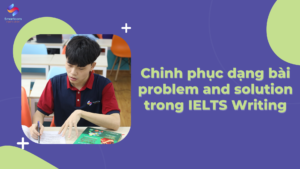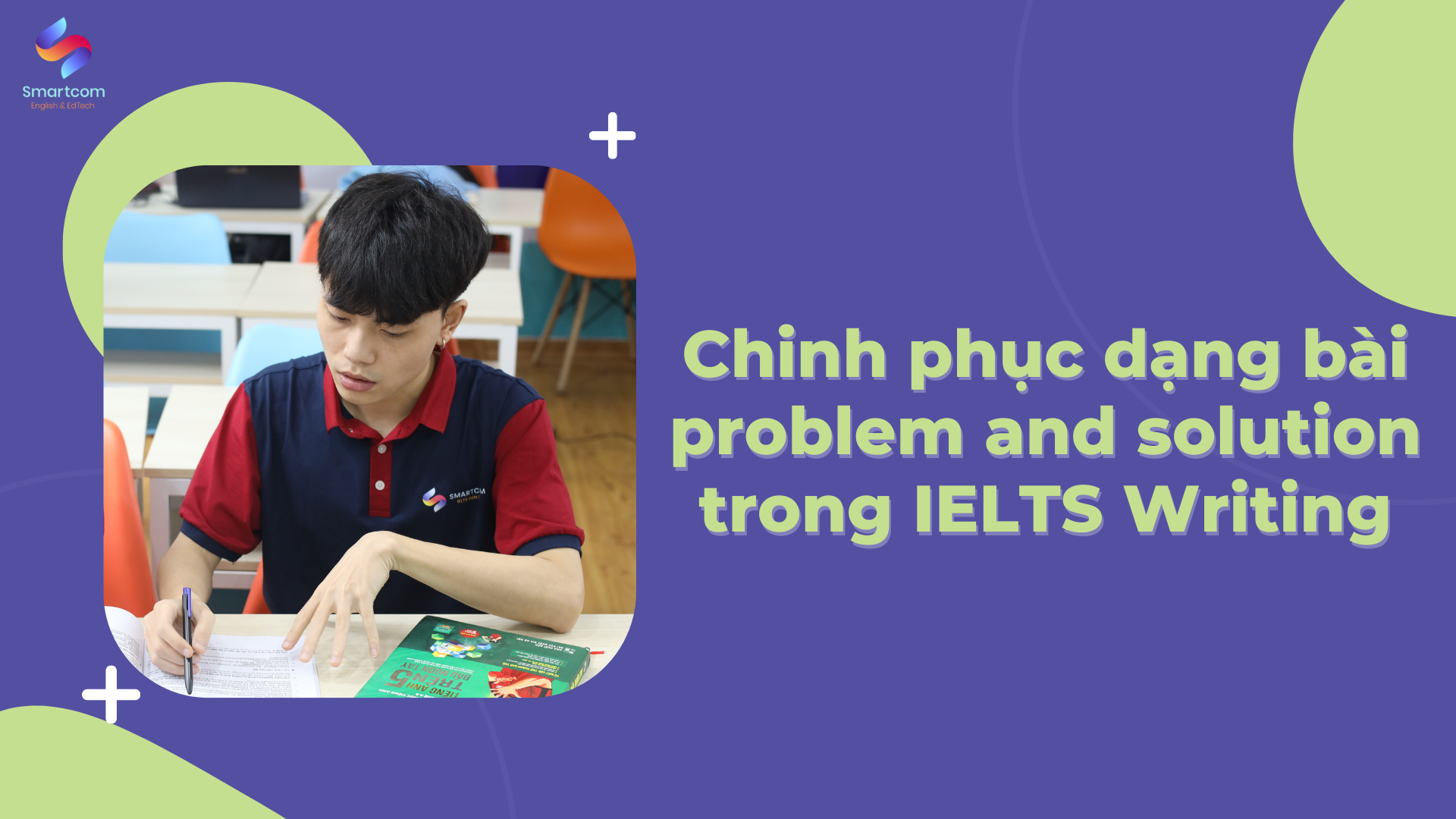Đội ngũ chuyên gia tại Smartcom English là tập hợp những chuyên gia đầu ngành trong lĩnh vực IELTS nói riêng và tiếng Anh nói chung. Với phương pháp giảng dạy sáng tạo, kết hợp với công nghệ AI, chúng tôi mang đến những trải nghiệm học tập độc đáo và hiệu quả. Mục tiêu lớn nhất của Smartcom Team là xây dựng một thế hệ trẻ tự tin, làm chủ ngôn ngữ và sẵn sàng vươn ra thế giới.
Đối với đa số thí sinh, phần thi Writing luôn được xem là phần khó nhất trong kỳ thi IELTS. Để tận dụng tối đa thời gian và đạt được điểm số tốt nhất, việc có một chiến lược ôn luyện rõ ràng và hiệu quả là rất quan trọng. Hãy cùng tìm hiểu tổng quan về IELTS Writing cũng như một số mẹo luyện tập dạng bài problem and solution cùng Smartcom English trong bài viết này nhé.

Những điều cần biết về IELTS Writing và dạng bài problem and solution
Cấu trúc phần thi IELTS Writing
Phần thi IELTS Writing gồm 2 bài Task 1 và Task 2 với tổng thời gian thi là 60 phút. Số từ quy định trong Task 1 là ít nhất 150 từ và Task 2 là ít nhất 250 từ.
Ở Task 1, thí sinh sẽ cần phân tích các biểu đồ (Line graph, Bar chart, Pie chart, Map,…) dựa trên số liệu đã cho sẵn.
Còn ở Task 2, thí sinh cần viết về những thông tin thực tế hơn, với các luận điểm và giải pháp. Một số dạng đề thường gặp ở Task 2 là Discussion Essay (To what extent do you agree or disagree?), Discussion Essay (Discuss these two views and give your opinion), Advantages and Disadvantages, Problem and Solution,…
Các tiêu chí chấm điểm cho phần thi IELTS Writing nhìn chung sẽ bao gồm:
Tiêu chí 1: Task Achievement/Response – câu trả lời phù hợp, thỏa mãn yêu cầu của đề bài
- Nội dung đúng theo yêu cầu đề bài, đủ ý
- Các ý được viết mạch lạc, rõ ràng
- Sử dụng ví dụ cụ thể để chứng minh
Tiêu chí 2: Coherence and Cohesion – có tính mạch lạc, chặt chẽ
- Dễ theo dõi nội dung muốn truyền tải của từng ý
- Sử dụng từ nối để tăng tính liên kết giữa các câu và đoạn văn
Tiêu chí 3: Lexical Resource – đánh giá vốn từ vựng
- Từ vựng phù hợp với nội dung bài viết
- Sử dụng từ vựng đa dạng
- Vận dụng được từ vựng nâng cao
Tiêu chí 4: Grammatical Range and Accuracy – phạm vi và độ chính xác của ngữ pháp được sử dụng
- Dùng đúng và đa dạng cấu trúc ngữ pháp
- Sử dụng dấu câu chính xác
Bên trên là các tiêu chí chấm điểm chung cho phần thi IELTS Writing, để tìm hiểu sâu hơn về từng tiêu chí một cách cụ thể thí sinh có thể liên hệ với các chuyên gia của Smartcom English theo thông tin ở cuối bài để được tư vấn.

Dạng bài problem and solution trong task 2 IELTS Writing
Problem and solution là một dạng bài trong Task 2 của phần thi IELTS Writing. Dạng bài này yêu cầu thí sinh chỉ ra được các vấn đề, ảnh hưởng tiêu cực của một tình huống cụ thể và từ đó đưa ra giải pháp để giải quyết chúng.
Một số câu hỏi để nhận biết dạng đề này là:
- What are the problems associated with this …?
- What are the causes/reasons?/Why is it the case?
- What measures should be taken to…?
- What action can be taken to prevent people having this problem?
Cách làm Writing task 2 problem and solution trong 3 bước
Bước 1: Xác định problem (vấn đề)
Khi nhận được đề bài, thay vì ngay lập tức cầm bút viết, bước đầu tiên thí sinh hãy phân tích kỹ đề để xác định được tình huống mà đề bài đưa ra và những problem cùng solution khả thi mà bản thân có thể triển khai.
Ví dụ đề bài:
Today, many people do not know their neighbors in large cities.
What problems does this cause?
What can be done about this?
Với đề bài này, thí sinh cần xác định được tình huống là ‘Many people do not know their neighbors in large cities’, từ đó nghĩ đến những problem khả thi để triển khai như ‘Less culturally unique neighborhoods’ và ‘Fading distinctiveness of communities’.
Sau khi đã xác định được problem, thí sinh có thể tiến đến bước 2.

Bước 2: Brainstorm dàn ý để tìm ra solution (giải pháp)
Việc brainstorm dàn ý sẽ giúp thí sinh có một hướng đi cụ thể ngay từ đầu, tránh được việc đang viết đến một nửa bài thì không nghĩ ra được ý tưởng hoặc quên mất ý tưởng ban đầu mình có.
Để tránh việc dành quá nhiều thời gian cho việc lên dàn ý, thí sinh có thể gạch đầu dòng các ý và sử dụng những cụm từ ngắn gọn, tránh viết cả câu dài dòng.
Ví dụ:
- Problem 1: Less culturally unique neighborhoods.
– Phát triển luận điểm:
+ Venice Beach in Los Angeles and Greenwich Village in New York City – people living here used to share similar values -> flourishing of a unique culture
+ “Beat Poets” of Greenwich
– Solution: Individual initiative – live in places having a heritage that suits yourself, not join mass movements toward gentrification
- Problem 2: Fading distinctiveness of communities.
– Phát triển luận điểm:
+ This distinctiveness of communities have value for locals and tourists
+ Without it -> feels little sentiment -> no shared identity
– Solution: expatriate enclaves in developing nations -> apply it on a larger scale

Bước 3: Viết bài theo đúng cấu trúc
Bước cuối cùng là bắt tay vào viết bài. Thí sinh cần viết đúng theo cấu trúc của một bài IELTS Writing Task 2, tránh việc trình bày theo sở thích mà làm mất điểm. Cấu trúc đúng của một bài IELTS Writing Task 2 bao gồm:
- Đoạn 1: Introduction
- Đoạn 2: Problems
- Đoạn 3: Solutions
- Đoạn 4: Conclusion
Ví dụ một bài viết đúng cấu trúc cho đề bài trên:
It is increasingly common in large urban areas for neighbors to interact less. In my opinion, this results in a declining sense of community and the solutions must be individually motivated.
In most cities today, the lack of connection between neighbors has caused less culturally unique neighborhoods. An illustrative counter-example to this would be famous neighborhoods such as Venice Beach in Los Angeles and Greenwich Village in New York City. In the past, individuals living in these areas shared similar values and that led to a flourishing of a unique culture. One result of such a sense of community was the “Beat Poets” of Greenwich. Related to this is the fading distinctiveness of communities that have value for locals and tourists alike. An individual living in a district in a major metropolis today feels little sentiment for its streets, buildings and other inhabitants and therefore derives nearly nothing in the way of a singular shared identity.
Remedies for the problems detailed above involve individual initiative. Governments attempting to contrive a sense of community will likely only provoke backlash. Instead, individuals could choose to live in parts of a city with a heritage that suits them and not join mass movements toward gentrification. A standout example of this would be expatriate enclaves in developing nations. These communities are able to preserve some of their cultural traditions and are entirely the result of individuals choosing to live together with those who represent their values and interests. This could be replicated on a larger scale if city residents choose their homes more thoughtfully and are more respectful of the traditions of any given community.
In conclusion, the problems stemming from less involvement between neighbors affect the community at large and should be dealt with by those most impacted by the ramifications. In this way, some cultural integrity can be preserved in a globalized world.

Câu hỏi mẫu và đáp án gợi ý cho dạng bài problem and solution
Câu hỏi mẫu:
A rise in the standard of living in a country often only seems to benefit cities rather than rural areas.
What problems can this cause?
How might these problems be reduced?
Đáp án gợi ý:
When standards of living increase, it is primarily urban residents, not those in the countryside, who benefit. In my opinion, this can lead to opposite problems related to population density and is best mitigated by governmental action.
Inequality in terms of standard of living engenders population problems for cities and rural regions. Cities have become over-populated in the last century as they offer a wider range of educational, occupational, and recreational options. Elevated population density means that although residents can enjoy a higher standard of living generally, they must also overcome concomitant effects from overcrowding such as more traffic, less sanitary conditions, and higher crime rates. The inverse problem exists outside cities as residents leave and locals struggle to earn a living in sparsely populated towns and villages.
These related problems can best be countered by the authorities. There are various initiatives that could be implemented. One real-world example of this would be in Japan where the government in recent years has addressed dwindling population numbers in the countryside by auctioning off country homes cheaply. Prospective home-owners are often able to buy houses nearly for free if they agree to live and work in a town with few residents. Another possible measure would be for governments to invest more in urban infrastructure. Since migrations to cities are likely inevitable, this is a more pragmatic tactic.
In conclusion, the inverse issues created for rural and urban areas by rising standards of living can be effectively controlled if governments intervene. This issue will only become more pressing as the global middle class continues to grow.

Xem thêm:
Tìm hiểu các dạng bài Writing Task 2 thường gặp
Mong rằng thông tin từ bài viết trên đã cung cấp cho bạn một tư liệu hữu ích về dạng bài problem and solution để ôn luyện cho kỹ năng Writing của bài thi IELTS. Để tiếp cận thêm bài viết bổ ích cho quá trình ôn luyện kỹ năng IELTS Writing nói riêng và cả 4 kỹ năng IELTS nói chung, hãy truy cập và theo dõi các bài đăng trên website của Smartcom English: smartcom.vn/blog
Bạn đang tìm nơi học IELTS chất lượng nhưng học phí vẫn trong tầm tay? Smartcom có đủ: uy tín – chi phí học IELTS hợp lý – cam kết đầu ra. Giải pháp cho câu hỏi học IELTS ở đâu tốt chính là đây. Đăng ký ngay để nhận ưu đãi hấp dẫn!
Thông tin liên hệ
Smartcom English
Trụ sở chính: Smartcom English – Tầng 4 nhà 29T2, đường Hoàng Đạo Thúy, khu đô thị Trung Hòa Nhân Chính, quận Cầu Giấy, Hà Nội.
Website: https://smartcom.vn
Điện thoại: (+84) 024.22427799
Zalo: 0865835099
Email: mail@smartcom.vn
Facebook: https://facebook.com/smartcom.vn
Youtube: https://youtube.com/c/smartcomvn
Kết nối với mình qua
Bài viết khác


![[PDF + Audio] Tải Sách IELTS Cambridge 19 (Kèm đáp án)](https://smartcom.vn/blog/wp-content/uploads/2024/06/ielts-cambridge-19_optimized.png)



![[PDF + Audio] Tải Sách IELTS Cambridge 17 (Kèm đáp án)](https://smartcom.vn/blog/wp-content/uploads/2024/07/sach-ielts-cambridge-17_optimized.jpg)
![[PDF + Audio] Tải Sách IELTS Cambridge 15 (Kèm đáp án)](https://smartcom.vn/blog/wp-content/uploads/2024/07/ielts-cambridge-15_optimized.jpg)








